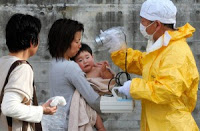Madison Ruppert, Contributor
Activist Post
If you thought the disasters at Chernobyl and Fukushima were isolated incidents which will never be repeated in the future, a new study indicates that you might be dead wrong.
The horrific situation at Fukushima is much worse than the mainstream media and government agencies have been telling us and if spent fuel pool four collapses, it will likely get considerably more deadly.
There is also the evolving situation at the nuclear facility in San Onofre, California. A recent report revealed that the circumstances there are much worse than previously thought and the potential for a large-scale disaster is still far too large to dismiss.
A new study conducted by scientists at the Max Planck Institute for Chemistry in Germany has found that the type of catastrophic events like the ones at Chernobyl and Fukushima are far more likely to occur than previously thought.
The researchers discovered that based on the operational hours of all civilian nuclear reactors and the number of meltdowns which have already occurred, events such as Chernobyl and Fukushima very well may occur once every ten to twenty years.
Keep in mind; this is only taking into account the current number of reactors.
This figure determined by the researchers is around 200 times more often than previously estimated.
A Max-Planck-Gesellschaft release states that the researchers also found that if this type of major accident were to occur, half of the radioactive cesium-137 would be distributed over an area larger than 1,000 kilometers away from the actual nuclear reactor.
Based on this, they determined that Western Europe is likely to be inundated by radioactive materials around once per fifty years by over forty kilobecquerel of cesium-137 per square meter.
The United Nations’ nuclear watchdog agency, the International Atomic Energy Agency (IAEA) has stated that an area is defined as contaminated with radiation from then onwards.
 The scientists’ findings led them to state that there is a desperate need for a new in-depth analysis and assessment of the true risks associated with nuclear power facilities.
The scientists’ findings led them to state that there is a desperate need for a new in-depth analysis and assessment of the true risks associated with nuclear power facilities.
Anti-nuclear power activists have been saying this for many years, even before we saw the horrific effects of Fukushima. Thankfully, it appears that researchers are finally backing up these calls.
Indeed, in the aftermath of the Fukushima disaster (which is, quite unfortunately, an ongoing one), the debate over nuclear power has re-emerged and some large nations like Germany have already moved away from nuclear power generation.
The study, which was conducted by a research team led by Jos Lelieveld, indicates that the global risk of a similar catastrophe is much larger than previously estimated.
Personally, I find it professionally irresponsible and borderline criminal to move forward with nuclear power programs knowing the risks involved.
“After Fukushima, the prospect of such an incident occurring again came into question, and whether we can actually calculate the radioactive fallout using our atmospheric models,” said Lelieveld, the director of the Max Planck Institute for Chemistry in Mainz.
The researchers determined the likelihood of a nuclear meltdown by dividing the operating hours of all civilian nuclear reactors on earth (from the commissioning of the first reactor up to the present day) by the number of reactor meltdowns which have already occurred.
The total number of operating hours is some 14,500 years, while the number of meltdowns is four: one in Chernobyl and a whopping three in Fukushima.
Thus, they determined that there would be at least one major nuclear accident – as defined according to the International Nuclear Event Scale (INES) – every 3,625 years.
Even if we act conservatively and round this up to one major accident every 5,000 reactor years, the risk is still a whopping 200 times higher than estimated in 1990 by the U.S. Nuclear Regulatory Commission (NRC) for catastrophic, non-contained core meltdowns.
With 440 nuclear reactors currently operational and over 60 additional reactors planned, the once in every ten to twenty years figure is far too large to consider a risk worth taking.
We must also take into account the fact that the researchers did not take into account ages and types of reactors – which can vary widely in reliability and safety.
Furthermore, they did not consider other factors which could make reactors more dangerous, such as reactors in regions with greater risk of earthquakes or other natural disasters.
 The geographical distribution of radioactive particles and gases was determined by utilizing a computer model of Earth’s atmosphere which calculates meteorological conditions and flows, while also taking into account chemical reactions in the atmosphere.
The geographical distribution of radioactive particles and gases was determined by utilizing a computer model of Earth’s atmosphere which calculates meteorological conditions and flows, while also taking into account chemical reactions in the atmosphere.
This model is able to compute the global distribution of even trace gases while also simulating the spread of radioactive gases and particles.
In their research, the scientists calculated approximately how the radioactive cesium-137 particles disperse in the atmosphere, where they might be deposited on the Earth’s surface and in what quantities.
For those who are unaware, cesium-137 is a product of the nuclear fission of uranium and has a half-life of thirty years, which means they decay quite rapidly. This was one of the most important factors in the massive radiological contamination in the wake of the meltdowns at Chernobyl and Fukushima.
Interestingly, the computer model determined that only 8 percent of the cesium-137 particles are, on average, expected to deposit in a 50 kilometer area around the actual nuclear accident site.
A whopping 50 percent of the particles would be deposited outside a radius of 1,000 kilometers of the reactor and an additional 25 percent would spread over 2,000 kilometers.
This shows that the potentially disastrous effects of nuclear reactor accidents are likely to create radioactive contamination well beyond the national borders of the country in which the meltdown occurred.
The researchers found that one of the most potentially dangerous areas in the world is Western Europe, due to the unusually high density of reactors.
In particular, the southwestern region of Germany has the highest risk of radioactive contamination across the world due to the many nuclear power plants located near the borders between Belgium, France and Germany in addition to the dominant westerly wind direction.
One of their most shocking conclusions was that a single nuclear meltdown in Western Europe could leave around 28 million people, on average, affected by contamination of over 40 kilobecquerels per square meter, which according to the IAEA is the level required to declare the area contaminated.
If such an accident were to occur in southern Asia where populations are especially dense, this number could jump to around 34 million people. In the eastern U.S. and East Asia the figure would be around 14-21 million people.
While Germany’s exit from nuclear power generation greatly reduces their risk of contamination, the risk would be even more significantly reduced if neighboring countries disabled their reactors as well.
“Not only do we need an in-depth and public analysis of the actual risks of nuclear accidents,” Lelieveld explained, “in light of our findings I believe an international coordinated phasing out of nuclear energy should be considered.”
 If the money poured into this field was diverted to the research and development of highly efficient, widespread commercial photovoltaic technology or other highly scalable renewable energy sources, there would be absolutely no need to resort to potentially deadly nuclear technology.
If the money poured into this field was diverted to the research and development of highly efficient, widespread commercial photovoltaic technology or other highly scalable renewable energy sources, there would be absolutely no need to resort to potentially deadly nuclear technology.
Furthermore, as an advocate of industrial hemp production, I see it as laughable to continue keeping the production of industrial hemp (especially for energy-generation purposes) illegal.
Considering all of the options we have at our disposal, the entire globe relying even in part on nuclear power generation is wholly nonsensical.
For more info see: Lelieveld, J., Kunkel, D., and Lawrence, M. G.: Global risk of radioactive fallout after major nuclear reactor accidents, Atmos. Chem. Phys., 12, 4245-4258, doi:10.5194/acp-12-4245-2012, 2012.
Did I forget anything or miss any errors? Would you like to make me aware of a story or subject to cover? Or perhaps you want to bring your writing to a wider audience? Feel free to contact me at admin@EndtheLie.com with your concerns, tips, questions, original writings, insults or just about anything that may strike your fancy.
Please support our work and help us start to pay contributors by doing your shopping through our Amazon link or check out some must-have products at our store.
This article first appeared at End the Lie.
linkwithin_text=’Related Articles:’



Be the first to comment on "Study shows nuclear reactor core meltdowns may occur once every 10-20 years"